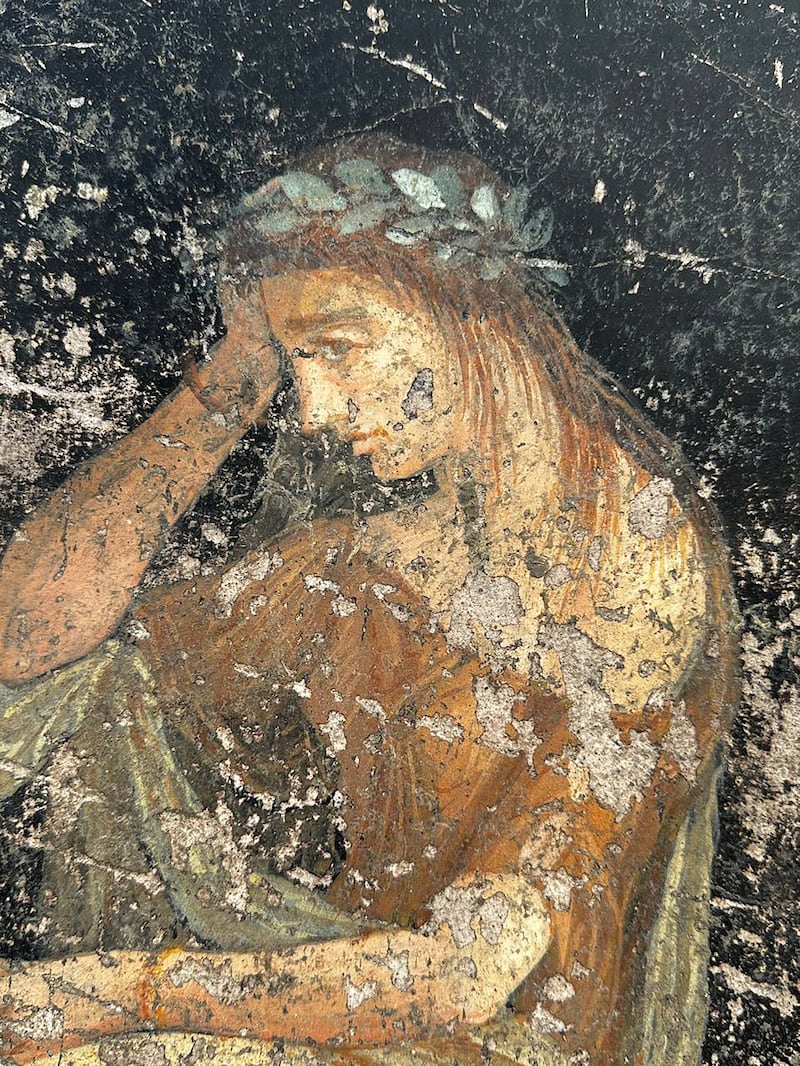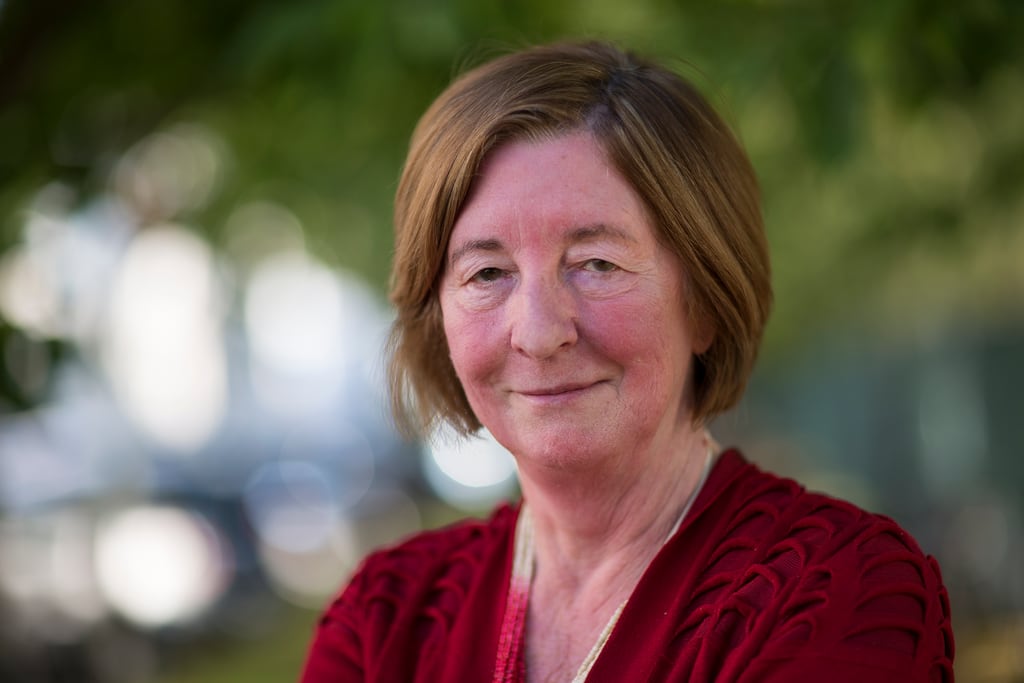Pat Barker pops up on Zoom in an electric-blue room flanked by guitars, keyboards and an accordion. It’s not quite the study stuffed with ancient-Greek tomes that I’d expected as a backdrop for the 81-year-old CBE-decorated author, her youthful countenance notwithstanding. Barker’s computer has died, she says, so she is dialling in from the room where her son-in-law teaches music in a village near her home in Durham, in northern England.
We laugh about the books often displayed as a flex on Zoom calls – an “impressive collection of the classics” with the spines uncracked. Barker’s copy of one classic in particular is, of course, well worn. The Voyage Home, her new book, is the third of a series of novels inspired by the Iliad, following her 2018 novel The Silence of the Girls, which was shortlisted for the Women’s Prize for Fiction, and her bestseller The Women of Troy, from 2021.
Barker has reread some parts of The Iliad “a lot more than others”, she says, conceding that “the inventory of ships is not a riveting read”. The storylines “with Achilles are the bits you go back to, because he is a tremendous character, one of the world’s great characters”. She loves “the meeting between him and Priam, which is iconic in lots of ways”, showing both the possibilities and the difficulties of reconciliation between enemies. “All over the world that’s what we’re faced with.”
[ Pat Barker: ‘Anne Boleyn can’t walk into our world but Helen of Troy can’Opens in new window ]
The Voyage Home, which draws on Aeschylus as well as on Homer, weaves together the story of three Trojan women captured and enslaved by the Greeks after the mythical fall of Troy. It centres on Cassandra, King Priam’s daughter, who was bestowed the gift of prophecy by Apollo with a kiss but doomed never to be believed. Barker was drawn to the character because, rather than kill Cassandra when she refuses his advances, Apollo spits in her mouth and curses her. “It’s quite interesting that [he] took no for an answer, because that is not what Apollo was famous for,” says Barker. “He cursed her, but he didn’t kill her ... possibly because she was a princess as well as a priestess.”
READ MORE
The novel is predominantly narrated by Ritsa, Cassandra’s “body-slave”, who is tasked with controlling her bouts of “divine frenzy” and keeping her groomed as a concubine of King Agamemnon. Ritsa, a healer who has lost her teenage daughter to “sweating sickness”, is the best friend of Briseis, who narrated the first two books. Although she is “pure invention”, Barker confirms, body-slaves did exist in ancient Greece. It’s unlikely that they were called “catch-farts”, though, she adds mischievously, as that term is 18th-century slang. (Like its predecessors, The Voyage Home makes deliberate use of anachronisms.)
Meanwhile, back in Mycenae, Queen Clytemnestra awaits Agamemnon’s return. Helen of Troy’s plain twin sister, Clytemnestra, has spent the past 10 years plotting revenge on her husband for killing their eldest daughter, Iphigenia, whom he sacrificed in exchange for a fair wind for Troy. Menace pervades the palace, which is haunted by the ghosts of the three boys killed by Atreus, Agamemnon’s father, to avenge his brother. “I don’t think revenge is entirely pointless,” says Barker. “But it’s certainly cyclical.”
For Cassandra to speak but not be believed is another version of the “silence of the girls”. Barker is an aural writer: she hears the voices of her characters, sometimes years after a book is published. She likens writing dialogue to “sculpting silence”: “You start with the silence, and the voices come out of the silence, and they go back into the silence,” she says. Barker loves writing dialogue, so much so that it’s her litmus test for whether a project is working. “If I’m not hearing the voices, I know the work is completely dead, so there’s no point continuing with it ... It’s like breath on the mirror: if there’s no breath on the mirror, don’t bother with the resuscitation – they’re gone.”

Barker didn’t find her writing voice until her late 30s, after taking an Arvon course taught by Angela Carter, who became a mentor. Publishers had rejected Barker’s earlier efforts because she had been trying to write “sensitive books, the kind that [she] saw being admired”, rather than using her more authentic voice. Carter sent the manuscript of Union Street, about northern-English working-class women, from 1982, “to her great friend Carmen Callil”, at Virago, who became Barker’s publisher until Regeneration, her 1991 novel, when she moved to Viking Penguin, where her longstanding agent Clare Alexander was then an editor.
It was with the Regeneration trilogy, about the trauma of first World War soldiers, that Barker really broke through. Its third volume, The Ghost Road, was awarded the Man Booker Prize in 1995. Winning the Booker was transformational, “like winning an Oscar”, she says. “But you can’t stand on the podium and say, ‘I have written the best novel this year.’ The best novel that year might [not] even be on the shortlist.” Furthermore, Barker believes that, even with such accolades, a writer has never “arrived”. “You’re only as good as your last paragraph,” she says. (“And if you’re writing a rough first draft, as I think you should be doing, your last paragraph is always rubbish.”)
Barker was raised by a single mother and her grandparents. Her father’s identity never revealed by her mother, and Barker says this mystery was her impetus to write, along with her mother’s “various, sometimes quite outlandish statements about who he was”. What gets writers going “is not stories”, she says. “The last thing a writer needs, really, is a story. It’s the lies, the secrets, the silences, the accumulation of them over a long period of time. John le Carré is wonderful about this, because he had a fantasising father who was a bit of a rogue, and he knew that what was being presented to him was a facade. So obviously you want to see behind the facade, and ultimately the only way to get behind the facade is to write your way behind [it].”
There was a journalist who sat outside my house wanting to make me say that Jane Fonda ought not to have had a boob job
Whereas the first two books of the series came easily, The Voyage Home was “forged in the fire – the fire of Covid to begin with”, followed by health issues and a house move. Cassandra was not an easy character to warm to when writing the novel, says Barker. As Cassandra feels she must fulfil the prophecy of marrying and dying alongside Agamemnon, bringing down the kingdom that had destroyed Troy, her story has the advantage of offering a clear, dramatic ending. But it’s a passive role, and readers “don’t identify with passive characters”. Ritsa and Clytemnestra are “perhaps easier, stronger” characters. Ritsa “has at least the hope of a happy ending”.
Although film rights for The Voyage Home are still up for grabs, the adaptation of The Silence of the Girls is in progress, with the script being written by Emma Thompson. Barker was given the opportunity to read it and found it “nothing short of brilliant”, she says. “Adaptations are very strange,” she adds. Stanley and Iris, the 1990 film based on Union Street, was one of her “very few contacts” with the tabloid press. “There was a journalist who sat outside my house wanting to make me say that Jane Fonda ought not to have had a boob job. And all he got out of me was, ‘I think it’s her business, don’t you?’”
There may be a fourth book returning to bronze-age women, but probably not right away, says Barker, who has three ideas for projects vying for her attention. Briseis “has got an ongoing problem that she’s pregnant as a result of rape, and raises the question several times in The Woman of Troy of how do you love a child whose conception involved no consent whatsoever? Do you love that child? And everybody else around her has an agenda for that child; people are rubbing her stomach because this is the bloodline of Achilles. They all assume it’s a boy, of course – he’s going to be another Achilles. That’s all they want, and what the child wants, or what his mother wants, is unimaginable; it’s of no relevance whatsoever. That is an interesting situation to me.”
In the near term, Barker is looking forward to getting her computer back up and running and to presenting The Voyage Home at Durham Book Festival this autumn, when her son-in-law will play songs based on the book while Northern Stage actors perform excerpts. She is understandably excited for “something very different from the usual literary launch”. With 16 novels now under her belt, she has “done far too many of those”.
The Voyage Home is published by Hamish Hamilton on Thursday, August 22nd



















